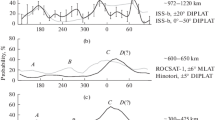Abstract
Ionosphere plasma irregularities known as equatorial plasma bubbles are the subject of this research. The variability of the latitudinal distributions of the occurrence probability of the bubbles with increasing the observation altitude is studied. For this purpose, the data from the ISS-b (~972–1220 km), ROCSAT-1 (~600 km), and AE-E (~300 km, ~350–475 km) satellites at the different orbital altitudes were used. Different seasons in the years of the increased and maximal solar activity were considered. (1) The latitudinal distributions of the equatorial plasma bubbles at the altitudes of their generation are shown to be basically the same at the altitudes of the topside ionosphere (~972–1220 km). This characteristic was revealed, because the bubbles at these altitudes were detected not as the depletions in the total ion or electron density but as the structures with depleted He+ density. (2) In addition to the central (equatorial) maximum, the additional mid-latitude maxima were found to develop in the latitudinal distributions of the occurrence probability of the bubbles with increasing the observation altitude (from ~600 to ~1000 km). This feature is the most pronounced in both hemispheres during the equinox and in the winter hemispheres. (3) The positions of the mid-latitude maxima were found to shift towards the equator with increasing the observation altitude. This is in good agreement with the spatial (latitudinal–altitudinal) course of the magnetic flux tubes along which the plasma bubbles that reached their ceiling altitudes are “stretched”.





Similar content being viewed by others
REFERENCES
Abdu, M.A., Outstanding problems in the equatorial ionosphere–thermosphere electrodynamics relevant to spread F, J. Atmos. Terr. Phys., 2001, vol. 63, no. 9, pp. 869–884.
Abdu, M.A., de Medeiros, R.T., Sobral, J.H.A., et al., Spread F plasma bubble vertical rise velocities determined from spaced ionosonde observations, J. Geophys. Res., 1983, vol. 88, pp. 9197–9204.
Abdu, M.A., Sobral, J.H.A., and Batista, I.S., Equatorial spread F statistics in the American longitudes: Some problems relevant to ESF description in the IRI scheme, Adv. Space Res., 2000, vol. 25, pp. 113–124.
Aggson, T.L., Maynard, N.C., Hanson, W.B., et al., Electric field observations of equatorial bubbles, J. Geophys. Res., 1992, vol. 97, pp. 2997–3009.
Bryunelli, B.E. and Namgaladze, A.A., Fizika ionosfery (Ionospheric Physics), Moscow: Nauka, 1988.
Burke, W.J., Donatelli, D.E., Sagalyn, R.C., et al., Low density regions observed at high altitudes and their connection with equatorial spread F, Planet. Space Sci., 1979, vol. 27, pp. 593–601.
Chandra, S., The equatorial helium ion trough and the geomagnetic anomaly, J. Atmos. Terr. Phys., 1975, vol. 37, no. 2, pp. 359–367.
Chandra, S., Troy, B.E., Jr., Donley, J.L., et al., “OGO-4" observations of ion composition and temperatures in the topside ionosphere, J. Geophys. Res.: Space, 1970, vol. 75, no. 19, pp. 3867–3878.
Gentile, L.C., Burke, W.J., and Rich, F.J., A climatology of equatorial plasma bubbles from DMSP 1989–2004, Radio Sci., 2006, vol. 41, RS5S21. https://doi.org/10.1029/2005RS003340
Heelis, R.A., Hanson, W.B., and Bailey, G.J., Distributions of He+ at middle and equatorial latitudes during solar maximum, J. Geophys. Res., 1990, vol. 95, no. A7, pp. 10313–10320.
Huba, J.D., Joyce, G., and Krall, J., Three-dimensional equatorial spread F modeling, Geophys. Res. Lett., 2008, vol. 35, L10102. https://doi.org/10.1029/2008GL033509
Hysell, D.L. and Kudeki, E., Collisional shear instability in the equatorial F region ionosphere, J. Geophys. Res., 2004, vol. 109, A11301. https://doi.org/10.1029/2004JA010636
Kil, H. and Heelis, R.A., Global distribution of density irregularities in the equatorial ionosphere, J. Geophys. Res., 1998, vol. 103, no. A1, pp. 407–417.
Krall, J., Huba, J.D., Ossakow, S.L., and Joyce, G., Why do equatorial ionospheric bubbles stop rising?, Geophys. Res. Lett., 2010, vol. 37, L09105. https://doi.org/10.1029/2010GL043128
Kudeki, E. and Bhattacharyya, S., Postsunset vortex in equatorial F-region plasma drifts and implications for bottomside spread-F, J. Geophys. Res., 1999, vol. 104, no. 12, pp. 28163–28170.
Kudeki, E., Akgiray, A., Milla, M.A., Chau, J.L., and Hysell, D.L., Equatorial spread-F initiation: Post-sunset vortex, thermospheric winds, gravity waves, J. Atmos. Sol.-Terr. Phys., 2007, vol. 69, nos. 17–18, pp. 2416–2427.
Maryama, T. and Matuura, N., Global distribution of occurrence probability of spread echoes based on ISS-B observation, J. Radio Res. Lab., 1980, vol. 27, no. 124, pp. 201–216.
McClure, J.P., Hanson, W.B., and Hoffman, J.F., Plasma bubbles and irregularities in the equatorial ionosphere, J. Geophys. Res., 1977, vol. 82, no. 19, pp. 2650–2656.
Ossakov, S.L. and Chaturvedi, P.K., Morphological studies of rising equatorial spread F bubbles, J. Geophys. Res., 1978, vol. 83, no. A5, pp. 2085–2090.
Ott, E., Theory of Rayleigh–Taylor bubbles in the equatorial ionosphere, J. Geophys. Res., 1978, vol. 83, no. A5, pp. 2066–2070.
RRL, Summary Plots of Ionospheric Parameters Obtained from Ionosphere Sounding Satellite-B, Tokyo: Radio Res. Lab. Min. Posts Telecom., 1983, vols. 1–3.
RRL, Summary Plots of Ionospheric Parameters Obtained from Ionosphere Sounding Satellite-B, Special Report, Tokyo: Radio Res. Lab. Min. Posts Telecom., 1985, vol. 4.
Sidorova, L.N., Plasma bubble phenomenon in the topside ionosphere, Adv. Space Res., 2007, vol. 39, no. 8, pp. 1284–1291. https://doi.org/10.1016/j.asr.2007.03.067
Sidorova, L.N., Equatorial plasma bubbles at altitudes of the topside ionosphere, Geomagn. Aeron. (Engl. Transl.), 2008a, vol. 48, no. 1, pp. 56–65.
Sidorova, L.N., Topside plasma bubbles, seen as He+ density depletions, in Fundamental Space Research. Conference Proceedings, Sunny Beach, Bulgaria, 2008b, p. 238.
Sidorova, L.N. and Filippov, S.V., Topside ionosphere He+ density depletions: Seasonal/longitudinal occurrence probability, J. Atmos. Sol.-Terr. Phys., 2012, vol. 86, pp. 83–91. https://doi.org/10.1016/j.jastp.2012.06.013
Sidorova, L.N. and Filippov, S.V., Longitudinal statistics of plasma bubbles observed as He+ density depletions at altitudes of the topside ionosphere, Geomagn. Aeron. (Engl. Transl.), 2013, vol. 53, no. 1, pp. 60–72.
Sidorova, L.N. and Filippov, S.V., Plasma bubble registration at altitudes of the topside ionosphere: Numerical evaluations, Geomagn. Aeron. (Engl. Transl.), 2014a, vol. 54, no. 3, pp. 329–336.
Sidorova, L.N. and Filippov, S.V., Plasma bubbles in the topside ionosphere: Estimations of the survival possibilities, J. Atmos. Sol.-Terr. Phys., 2014b, vol. 119, pp. 35–41. https://doi.org/10.1016/j.jastp.2014.06.013
Sidorova, L.N. and Filippov, S.V., Equatorial plasma bubbles: Effect of thermospheric winds modulated by DE3 tidal waves, Geomagn. Aeron. (Engl. Transl.), 2018, vol. 58, no. 2, pp. 214–222.
Sidorova, L.N. and Filippov, S.V., Wind preparation of the generation of equatorial plasma “bubbles”, Geomagn. Aeron. (Engl. Transl.), 2019, vol. 59, no. 3, pp. 312–317. https://doi.org/10.1134/S0016793219030137
Su, S.-Y., Liu, C.H., Ho, H.H., et al., Distribution characteristics of topside ionospheric density irregularities: Equatorial versus midlatitude regions, J. Geophys. Res., 2006, vol. 111, A06305. https://doi.org/10.1029/2005JA011330
Taylor, H.A., Jr., Mayr, H.G., and Brinton, H.C., Observations of hydrogen and helium ions during a period of rising solar activity, Space Res., 1970, vol. 10, pp. 663–678.
Tsunoda, R.T., Magnetic-field-aligned characteristics of plasma bubbles in the nighttime equatorial ionosphere, J. Atmos. Terr. Phys., 1980, vol. 42, pp. 743–752.
Wilford, C.R., Moffett, R.J., Rees, J.M., Bailey, G.J., and Gonzalez, S.A., Comparison of the He+ layer observed over Arecibo during solar maximum and solar minimum with CTIP model results, J. Geophys. Res., 2003, vol. 108, no. A12, pp. 1452–1461. https://doi.org/10.1029/2003JA009940
Woodman, R.F. and La Hoz, C., Radar observations of F‑region equatorial irregularities, J. Geophys. Res., 1976, vol. 81, pp. 5447–5466.
Author information
Authors and Affiliations
Corresponding author
Additional information
Translated by A. Ivanov
Rights and permissions
About this article
Cite this article
Sidorova, L.N. Equatorial Plasma Bubbles: Variability of the Latitudinal Distribution with Altitude. Geomagn. Aeron. 61, 508–519 (2021). https://doi.org/10.1134/S0016793221040162
Received:
Revised:
Accepted:
Published:
Issue Date:
DOI: https://doi.org/10.1134/S0016793221040162




